Organisational Behaviour Report: Influence on Individual and Team
VerifiedAdded on 2023/01/19
|13
|3774
|43
Report
AI Summary
This report provides an analysis of organisational behaviour within the context of Tesco, a multinational retailer. It examines the influence of organisational culture, politics, and power on individual and team behaviour and performance, using Handy's cultural typology model. The report also evaluates content and process theories of motivation, including Maslow's Hierarchy of Needs, McClelland's theory, the expectancy theory, and the equity theory, to understand employee motivation. Furthermore, it explores the characteristics of effective and ineffective teams and applies organisational behaviour concepts to a given business situation. The report aims to provide insights into how Tesco can enhance employee performance and overall organisational effectiveness through the application of these principles.
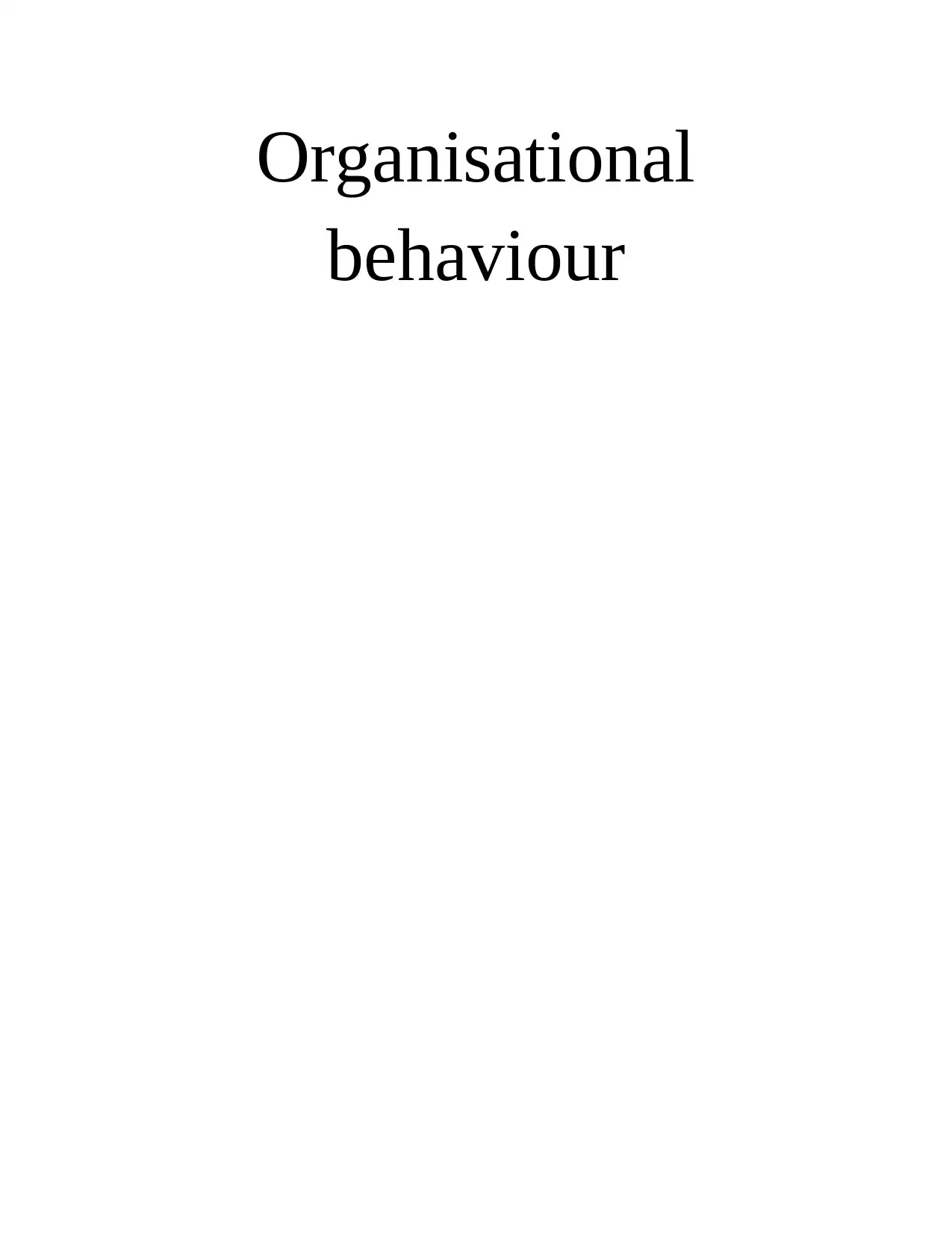
Organisational
behaviour
behaviour
Paraphrase This Document
Need a fresh take? Get an instant paraphrase of this document with our AI Paraphraser
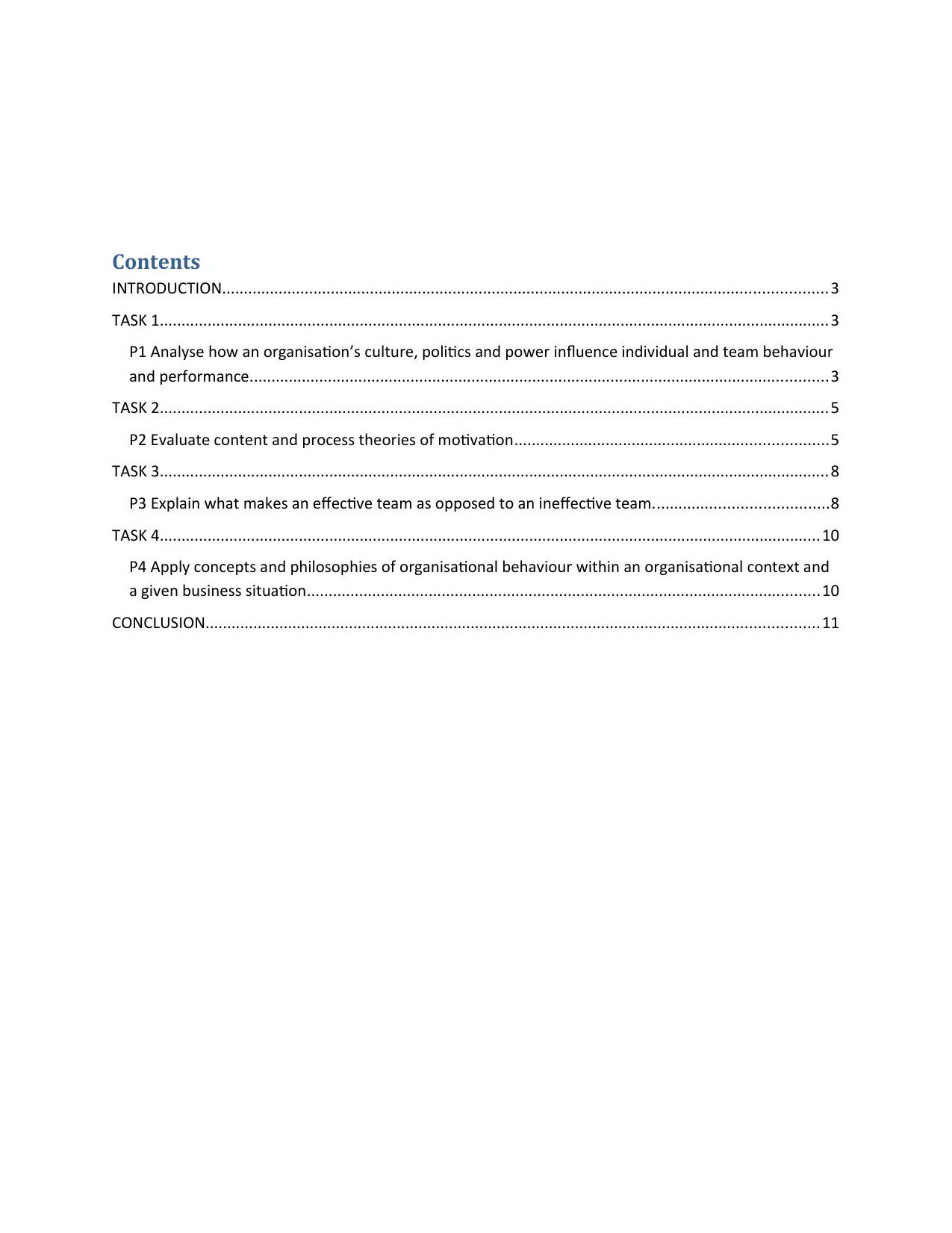
Contents
INTRODUCTION...........................................................................................................................................3
TASK 1..........................................................................................................................................................3
P1 Analyse how an organisation’s culture, politics and power influence individual and team behaviour
and performance.....................................................................................................................................3
TASK 2..........................................................................................................................................................5
P2 Evaluate content and process theories of motivation........................................................................5
TASK 3..........................................................................................................................................................8
P3 Explain what makes an effective team as opposed to an ineffective team........................................8
TASK 4........................................................................................................................................................10
P4 Apply concepts and philosophies of organisational behaviour within an organisational context and
a given business situation......................................................................................................................10
CONCLUSION.............................................................................................................................................11
INTRODUCTION...........................................................................................................................................3
TASK 1..........................................................................................................................................................3
P1 Analyse how an organisation’s culture, politics and power influence individual and team behaviour
and performance.....................................................................................................................................3
TASK 2..........................................................................................................................................................5
P2 Evaluate content and process theories of motivation........................................................................5
TASK 3..........................................................................................................................................................8
P3 Explain what makes an effective team as opposed to an ineffective team........................................8
TASK 4........................................................................................................................................................10
P4 Apply concepts and philosophies of organisational behaviour within an organisational context and
a given business situation......................................................................................................................10
CONCLUSION.............................................................................................................................................11
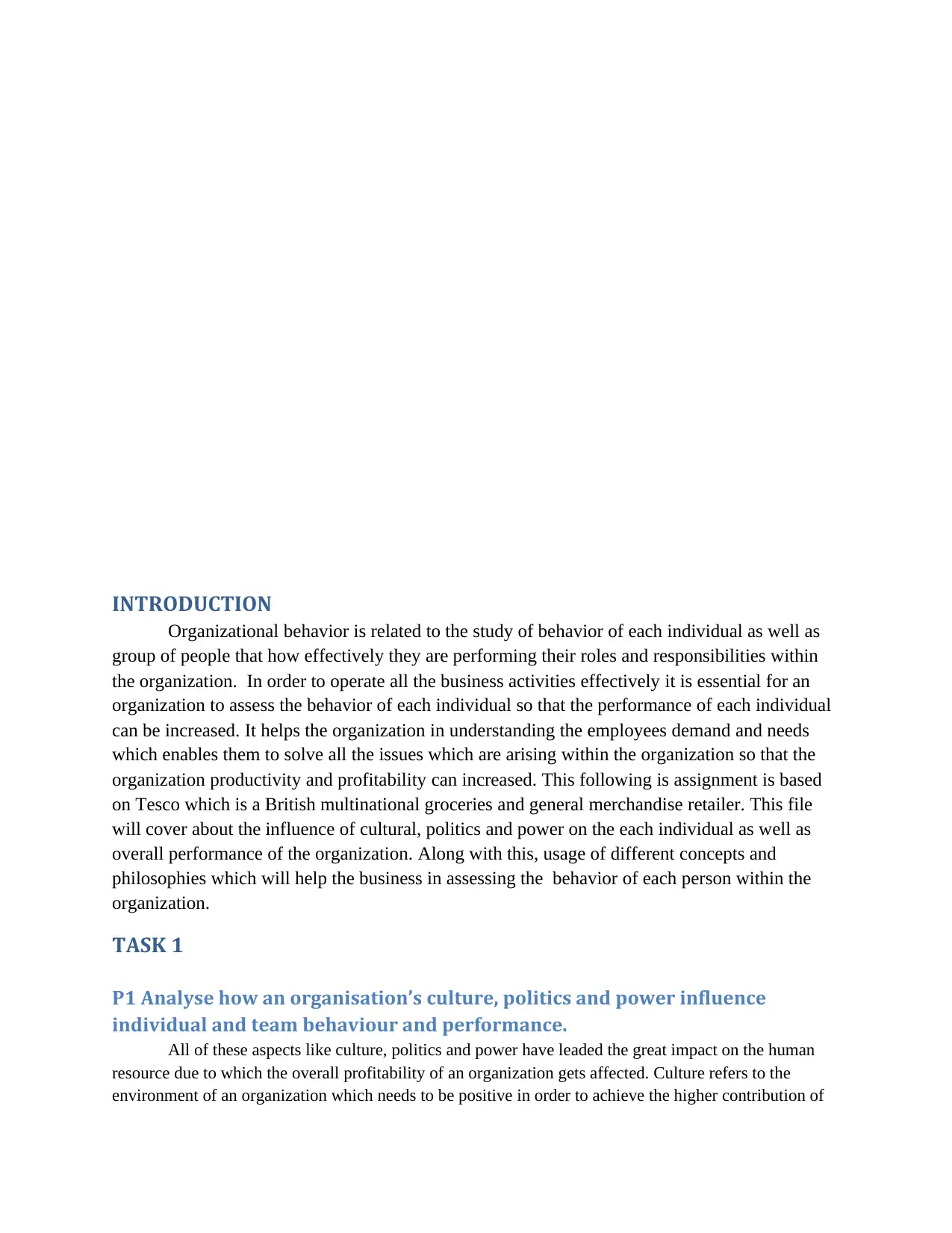
INTRODUCTION
Organizational behavior is related to the study of behavior of each individual as well as
group of people that how effectively they are performing their roles and responsibilities within
the organization. In order to operate all the business activities effectively it is essential for an
organization to assess the behavior of each individual so that the performance of each individual
can be increased. It helps the organization in understanding the employees demand and needs
which enables them to solve all the issues which are arising within the organization so that the
organization productivity and profitability can increased. This following is assignment is based
on Tesco which is a British multinational groceries and general merchandise retailer. This file
will cover about the influence of cultural, politics and power on the each individual as well as
overall performance of the organization. Along with this, usage of different concepts and
philosophies which will help the business in assessing the behavior of each person within the
organization.
TASK 1
P1 Analyse how an organisation’s culture, politics and power influence
individual and team behaviour and performance.
All of these aspects like culture, politics and power have leaded the great impact on the human
resource due to which the overall profitability of an organization gets affected. Culture refers to the
environment of an organization which needs to be positive in order to achieve the higher contribution of
Organizational behavior is related to the study of behavior of each individual as well as
group of people that how effectively they are performing their roles and responsibilities within
the organization. In order to operate all the business activities effectively it is essential for an
organization to assess the behavior of each individual so that the performance of each individual
can be increased. It helps the organization in understanding the employees demand and needs
which enables them to solve all the issues which are arising within the organization so that the
organization productivity and profitability can increased. This following is assignment is based
on Tesco which is a British multinational groceries and general merchandise retailer. This file
will cover about the influence of cultural, politics and power on the each individual as well as
overall performance of the organization. Along with this, usage of different concepts and
philosophies which will help the business in assessing the behavior of each person within the
organization.
TASK 1
P1 Analyse how an organisation’s culture, politics and power influence
individual and team behaviour and performance.
All of these aspects like culture, politics and power have leaded the great impact on the human
resource due to which the overall profitability of an organization gets affected. Culture refers to the
environment of an organization which needs to be positive in order to achieve the higher contribution of
⊘ This is a preview!⊘
Do you want full access?
Subscribe today to unlock all pages.

Trusted by 1+ million students worldwide
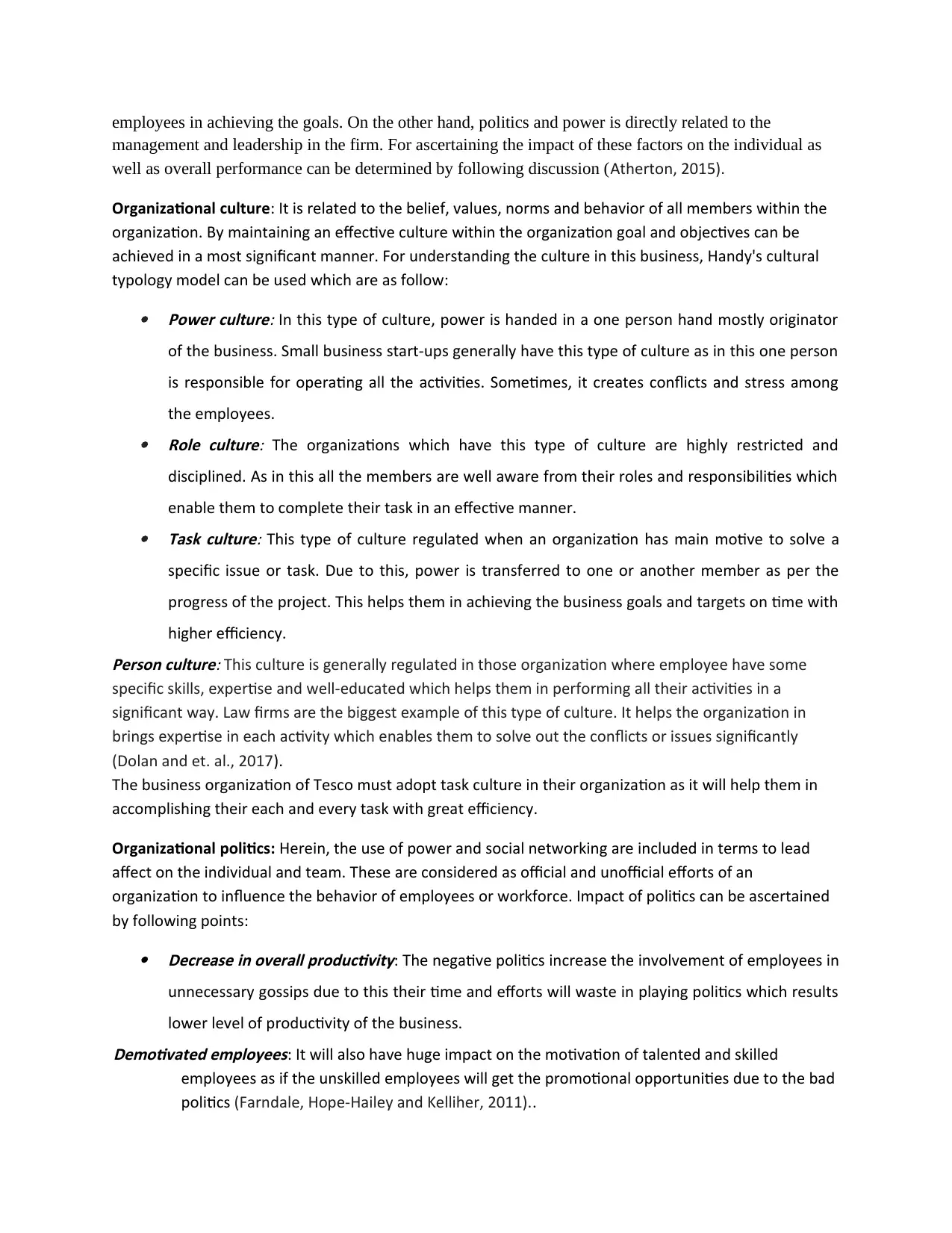
employees in achieving the goals. On the other hand, politics and power is directly related to the
management and leadership in the firm. For ascertaining the impact of these factors on the individual as
well as overall performance can be determined by following discussion (Atherton, 2015).
Organizational culture: It is related to the belief, values, norms and behavior of all members within the
organization. By maintaining an effective culture within the organization goal and objectives can be
achieved in a most significant manner. For understanding the culture in this business, Handy's cultural
typology model can be used which are as follow: Power culture: In this type of culture, power is handed in a one person hand mostly originator
of the business. Small business start-ups generally have this type of culture as in this one person
is responsible for operating all the activities. Sometimes, it creates conflicts and stress among
the employees. Role culture: The organizations which have this type of culture are highly restricted and
disciplined. As in this all the members are well aware from their roles and responsibilities which
enable them to complete their task in an effective manner. Task culture: This type of culture regulated when an organization has main motive to solve a
specific issue or task. Due to this, power is transferred to one or another member as per the
progress of the project. This helps them in achieving the business goals and targets on time with
higher efficiency.Person culture: This culture is generally regulated in those organization where employee have some
specific skills, expertise and well-educated which helps them in performing all their activities in a
significant way. Law firms are the biggest example of this type of culture. It helps the organization in
brings expertise in each activity which enables them to solve out the conflicts or issues significantly
(Dolan and et. al., 2017).
The business organization of Tesco must adopt task culture in their organization as it will help them in
accomplishing their each and every task with great efficiency.
Organizational politics: Herein, the use of power and social networking are included in terms to lead
affect on the individual and team. These are considered as official and unofficial efforts of an
organization to influence the behavior of employees or workforce. Impact of politics can be ascertained
by following points: Decrease in overall productivity: The negative politics increase the involvement of employees in
unnecessary gossips due to this their time and efforts will waste in playing politics which results
lower level of productivity of the business.Demotivated employees: It will also have huge impact on the motivation of talented and skilled
employees as if the unskilled employees will get the promotional opportunities due to the bad
politics (Farndale, Hope-Hailey and Kelliher, 2011)..
management and leadership in the firm. For ascertaining the impact of these factors on the individual as
well as overall performance can be determined by following discussion (Atherton, 2015).
Organizational culture: It is related to the belief, values, norms and behavior of all members within the
organization. By maintaining an effective culture within the organization goal and objectives can be
achieved in a most significant manner. For understanding the culture in this business, Handy's cultural
typology model can be used which are as follow: Power culture: In this type of culture, power is handed in a one person hand mostly originator
of the business. Small business start-ups generally have this type of culture as in this one person
is responsible for operating all the activities. Sometimes, it creates conflicts and stress among
the employees. Role culture: The organizations which have this type of culture are highly restricted and
disciplined. As in this all the members are well aware from their roles and responsibilities which
enable them to complete their task in an effective manner. Task culture: This type of culture regulated when an organization has main motive to solve a
specific issue or task. Due to this, power is transferred to one or another member as per the
progress of the project. This helps them in achieving the business goals and targets on time with
higher efficiency.Person culture: This culture is generally regulated in those organization where employee have some
specific skills, expertise and well-educated which helps them in performing all their activities in a
significant way. Law firms are the biggest example of this type of culture. It helps the organization in
brings expertise in each activity which enables them to solve out the conflicts or issues significantly
(Dolan and et. al., 2017).
The business organization of Tesco must adopt task culture in their organization as it will help them in
accomplishing their each and every task with great efficiency.
Organizational politics: Herein, the use of power and social networking are included in terms to lead
affect on the individual and team. These are considered as official and unofficial efforts of an
organization to influence the behavior of employees or workforce. Impact of politics can be ascertained
by following points: Decrease in overall productivity: The negative politics increase the involvement of employees in
unnecessary gossips due to this their time and efforts will waste in playing politics which results
lower level of productivity of the business.Demotivated employees: It will also have huge impact on the motivation of talented and skilled
employees as if the unskilled employees will get the promotional opportunities due to the bad
politics (Farndale, Hope-Hailey and Kelliher, 2011)..
Paraphrase This Document
Need a fresh take? Get an instant paraphrase of this document with our AI Paraphraser
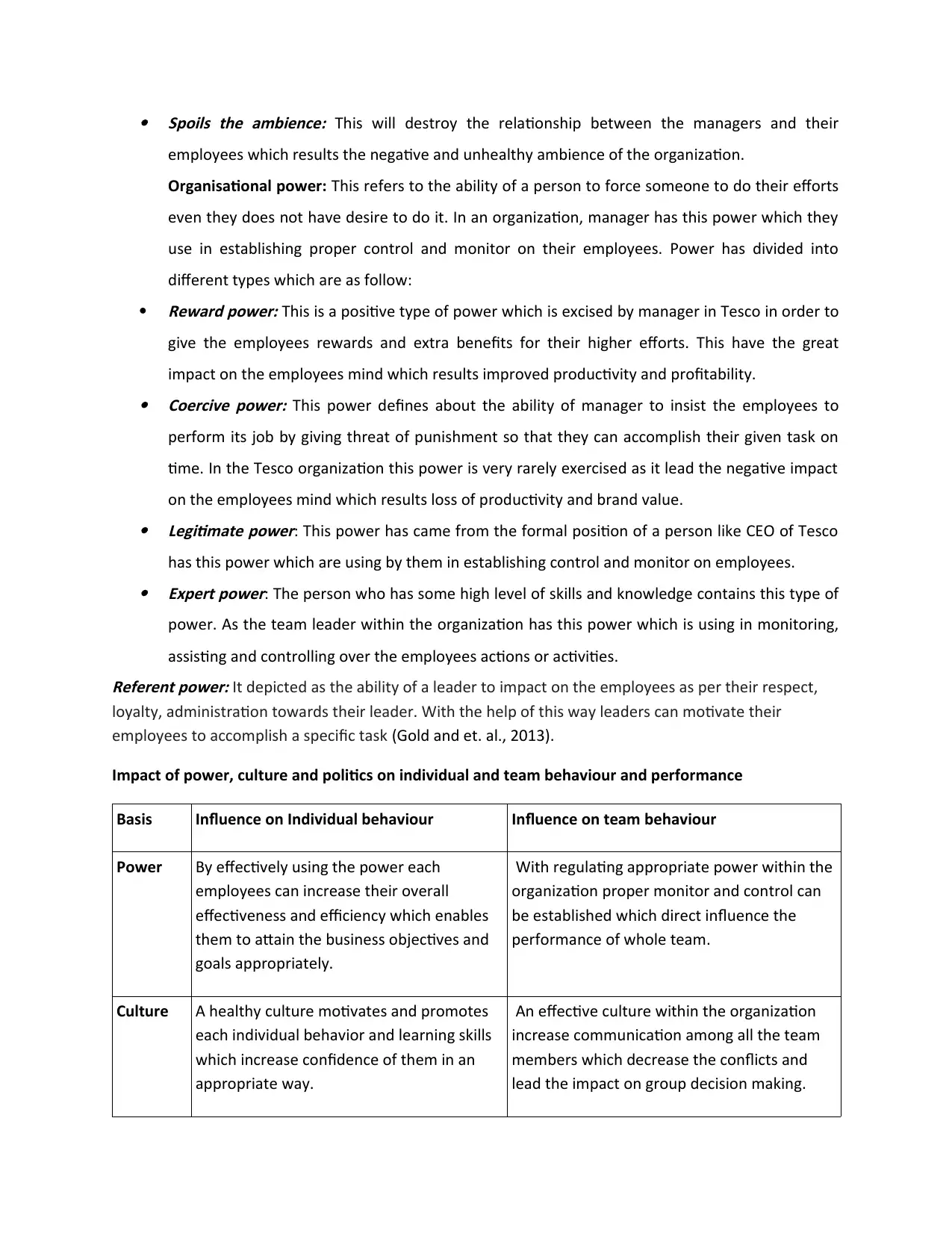
Spoils the ambience: This will destroy the relationship between the managers and their
employees which results the negative and unhealthy ambience of the organization.
Organisational power: This refers to the ability of a person to force someone to do their efforts
even they does not have desire to do it. In an organization, manager has this power which they
use in establishing proper control and monitor on their employees. Power has divided into
different types which are as follow:
Reward power: This is a positive type of power which is excised by manager in Tesco in order to
give the employees rewards and extra benefits for their higher efforts. This have the great
impact on the employees mind which results improved productivity and profitability. Coercive power: This power defines about the ability of manager to insist the employees to
perform its job by giving threat of punishment so that they can accomplish their given task on
time. In the Tesco organization this power is very rarely exercised as it lead the negative impact
on the employees mind which results loss of productivity and brand value. Legitimate power: This power has came from the formal position of a person like CEO of Tesco
has this power which are using by them in establishing control and monitor on employees. Expert power: The person who has some high level of skills and knowledge contains this type of
power. As the team leader within the organization has this power which is using in monitoring,
assisting and controlling over the employees actions or activities.Referent power: It depicted as the ability of a leader to impact on the employees as per their respect,
loyalty, administration towards their leader. With the help of this way leaders can motivate their
employees to accomplish a specific task (Gold and et. al., 2013).
Impact of power, culture and politics on individual and team behaviour and performance
Basis Influence on Individual behaviour Influence on team behaviour
Power By effectively using the power each
employees can increase their overall
effectiveness and efficiency which enables
them to attain the business objectives and
goals appropriately.
With regulating appropriate power within the
organization proper monitor and control can
be established which direct influence the
performance of whole team.
Culture A healthy culture motivates and promotes
each individual behavior and learning skills
which increase confidence of them in an
appropriate way.
An effective culture within the organization
increase communication among all the team
members which decrease the conflicts and
lead the impact on group decision making.
employees which results the negative and unhealthy ambience of the organization.
Organisational power: This refers to the ability of a person to force someone to do their efforts
even they does not have desire to do it. In an organization, manager has this power which they
use in establishing proper control and monitor on their employees. Power has divided into
different types which are as follow:
Reward power: This is a positive type of power which is excised by manager in Tesco in order to
give the employees rewards and extra benefits for their higher efforts. This have the great
impact on the employees mind which results improved productivity and profitability. Coercive power: This power defines about the ability of manager to insist the employees to
perform its job by giving threat of punishment so that they can accomplish their given task on
time. In the Tesco organization this power is very rarely exercised as it lead the negative impact
on the employees mind which results loss of productivity and brand value. Legitimate power: This power has came from the formal position of a person like CEO of Tesco
has this power which are using by them in establishing control and monitor on employees. Expert power: The person who has some high level of skills and knowledge contains this type of
power. As the team leader within the organization has this power which is using in monitoring,
assisting and controlling over the employees actions or activities.Referent power: It depicted as the ability of a leader to impact on the employees as per their respect,
loyalty, administration towards their leader. With the help of this way leaders can motivate their
employees to accomplish a specific task (Gold and et. al., 2013).
Impact of power, culture and politics on individual and team behaviour and performance
Basis Influence on Individual behaviour Influence on team behaviour
Power By effectively using the power each
employees can increase their overall
effectiveness and efficiency which enables
them to attain the business objectives and
goals appropriately.
With regulating appropriate power within the
organization proper monitor and control can
be established which direct influence the
performance of whole team.
Culture A healthy culture motivates and promotes
each individual behavior and learning skills
which increase confidence of them in an
appropriate way.
An effective culture within the organization
increase communication among all the team
members which decrease the conflicts and
lead the impact on group decision making.
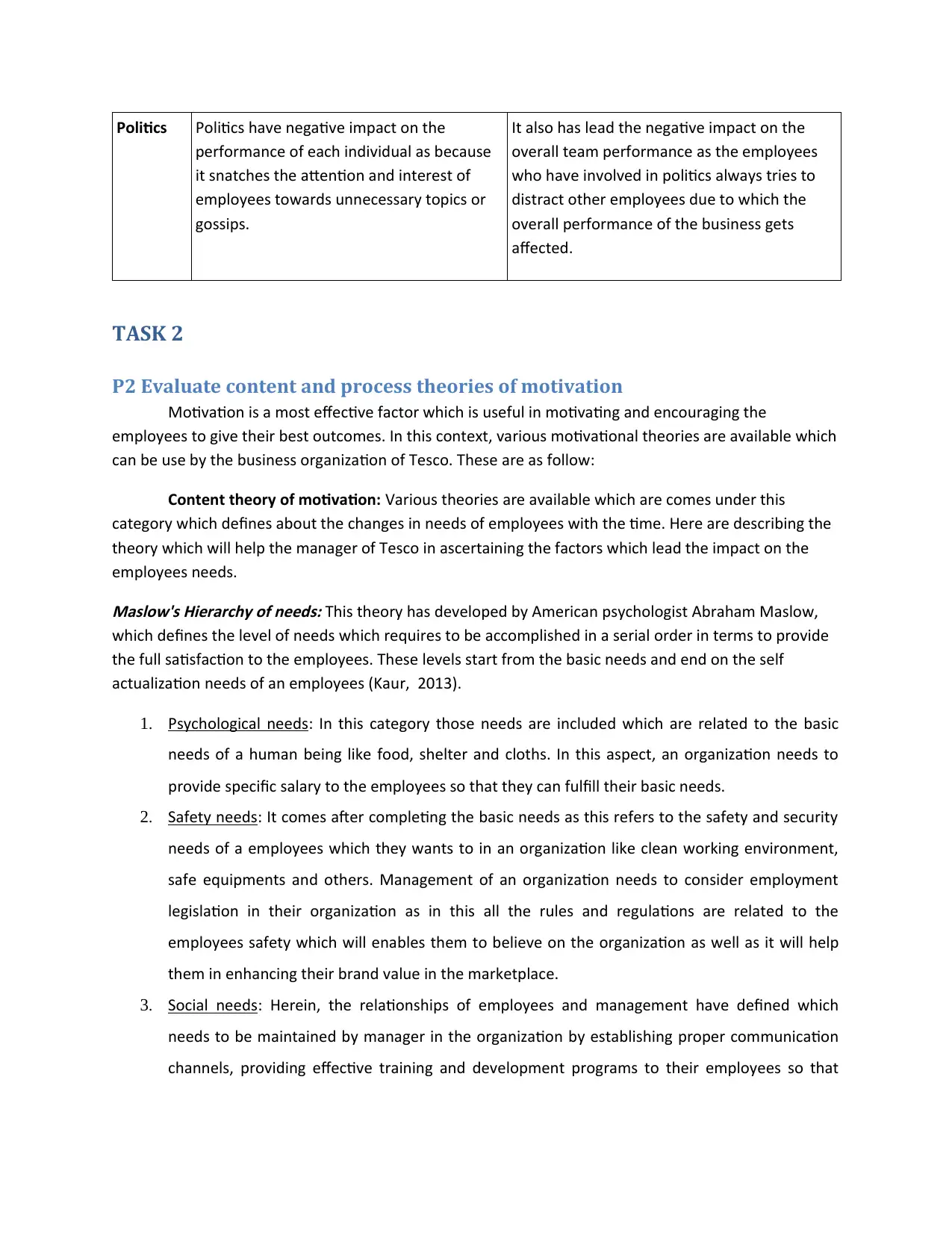
Politics Politics have negative impact on the
performance of each individual as because
it snatches the attention and interest of
employees towards unnecessary topics or
gossips.
It also has lead the negative impact on the
overall team performance as the employees
who have involved in politics always tries to
distract other employees due to which the
overall performance of the business gets
affected.
TASK 2
P2 Evaluate content and process theories of motivation
Motivation is a most effective factor which is useful in motivating and encouraging the
employees to give their best outcomes. In this context, various motivational theories are available which
can be use by the business organization of Tesco. These are as follow:
Content theory of motivation: Various theories are available which are comes under this
category which defines about the changes in needs of employees with the time. Here are describing the
theory which will help the manager of Tesco in ascertaining the factors which lead the impact on the
employees needs.
Maslow's Hierarchy of needs: This theory has developed by American psychologist Abraham Maslow,
which defines the level of needs which requires to be accomplished in a serial order in terms to provide
the full satisfaction to the employees. These levels start from the basic needs and end on the self
actualization needs of an employees (Kaur, 2013).
1. Psychological needs: In this category those needs are included which are related to the basic
needs of a human being like food, shelter and cloths. In this aspect, an organization needs to
provide specific salary to the employees so that they can fulfill their basic needs.
2. Safety needs: It comes after completing the basic needs as this refers to the safety and security
needs of a employees which they wants to in an organization like clean working environment,
safe equipments and others. Management of an organization needs to consider employment
legislation in their organization as in this all the rules and regulations are related to the
employees safety which will enables them to believe on the organization as well as it will help
them in enhancing their brand value in the marketplace.
3. Social needs: Herein, the relationships of employees and management have defined which
needs to be maintained by manager in the organization by establishing proper communication
channels, providing effective training and development programs to their employees so that
performance of each individual as because
it snatches the attention and interest of
employees towards unnecessary topics or
gossips.
It also has lead the negative impact on the
overall team performance as the employees
who have involved in politics always tries to
distract other employees due to which the
overall performance of the business gets
affected.
TASK 2
P2 Evaluate content and process theories of motivation
Motivation is a most effective factor which is useful in motivating and encouraging the
employees to give their best outcomes. In this context, various motivational theories are available which
can be use by the business organization of Tesco. These are as follow:
Content theory of motivation: Various theories are available which are comes under this
category which defines about the changes in needs of employees with the time. Here are describing the
theory which will help the manager of Tesco in ascertaining the factors which lead the impact on the
employees needs.
Maslow's Hierarchy of needs: This theory has developed by American psychologist Abraham Maslow,
which defines the level of needs which requires to be accomplished in a serial order in terms to provide
the full satisfaction to the employees. These levels start from the basic needs and end on the self
actualization needs of an employees (Kaur, 2013).
1. Psychological needs: In this category those needs are included which are related to the basic
needs of a human being like food, shelter and cloths. In this aspect, an organization needs to
provide specific salary to the employees so that they can fulfill their basic needs.
2. Safety needs: It comes after completing the basic needs as this refers to the safety and security
needs of a employees which they wants to in an organization like clean working environment,
safe equipments and others. Management of an organization needs to consider employment
legislation in their organization as in this all the rules and regulations are related to the
employees safety which will enables them to believe on the organization as well as it will help
them in enhancing their brand value in the marketplace.
3. Social needs: Herein, the relationships of employees and management have defined which
needs to be maintained by manager in the organization by establishing proper communication
channels, providing effective training and development programs to their employees so that
⊘ This is a preview!⊘
Do you want full access?
Subscribe today to unlock all pages.

Trusted by 1+ million students worldwide
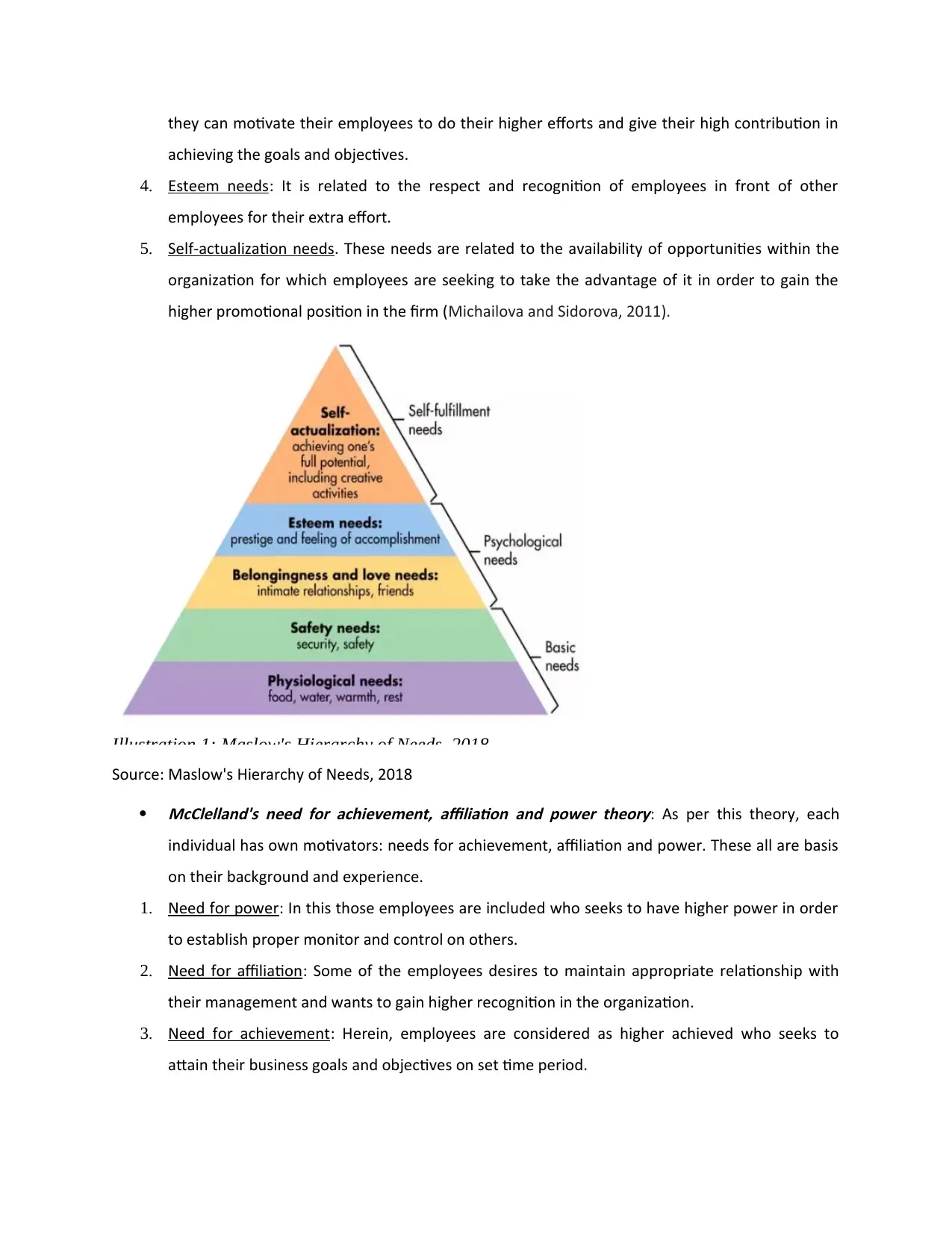
they can motivate their employees to do their higher efforts and give their high contribution in
achieving the goals and objectives.
4. Esteem needs: It is related to the respect and recognition of employees in front of other
employees for their extra effort.
5. Self-actualization needs. These needs are related to the availability of opportunities within the
organization for which employees are seeking to take the advantage of it in order to gain the
higher promotional position in the firm (Michailova and Sidorova, 2011).
Illustration 1: Maslow's Hierarchy of Needs. 2018
Source: Maslow's Hierarchy of Needs, 2018
McClelland's need for achievement, affiliation and power theory: As per this theory, each
individual has own motivators: needs for achievement, affiliation and power. These all are basis
on their background and experience.
1. Need for power: In this those employees are included who seeks to have higher power in order
to establish proper monitor and control on others.
2. Need for affiliation: Some of the employees desires to maintain appropriate relationship with
their management and wants to gain higher recognition in the organization.
3. Need for achievement: Herein, employees are considered as higher achieved who seeks to
attain their business goals and objectives on set time period.
achieving the goals and objectives.
4. Esteem needs: It is related to the respect and recognition of employees in front of other
employees for their extra effort.
5. Self-actualization needs. These needs are related to the availability of opportunities within the
organization for which employees are seeking to take the advantage of it in order to gain the
higher promotional position in the firm (Michailova and Sidorova, 2011).
Illustration 1: Maslow's Hierarchy of Needs. 2018
Source: Maslow's Hierarchy of Needs, 2018
McClelland's need for achievement, affiliation and power theory: As per this theory, each
individual has own motivators: needs for achievement, affiliation and power. These all are basis
on their background and experience.
1. Need for power: In this those employees are included who seeks to have higher power in order
to establish proper monitor and control on others.
2. Need for affiliation: Some of the employees desires to maintain appropriate relationship with
their management and wants to gain higher recognition in the organization.
3. Need for achievement: Herein, employees are considered as higher achieved who seeks to
attain their business goals and objectives on set time period.
Paraphrase This Document
Need a fresh take? Get an instant paraphrase of this document with our AI Paraphraser
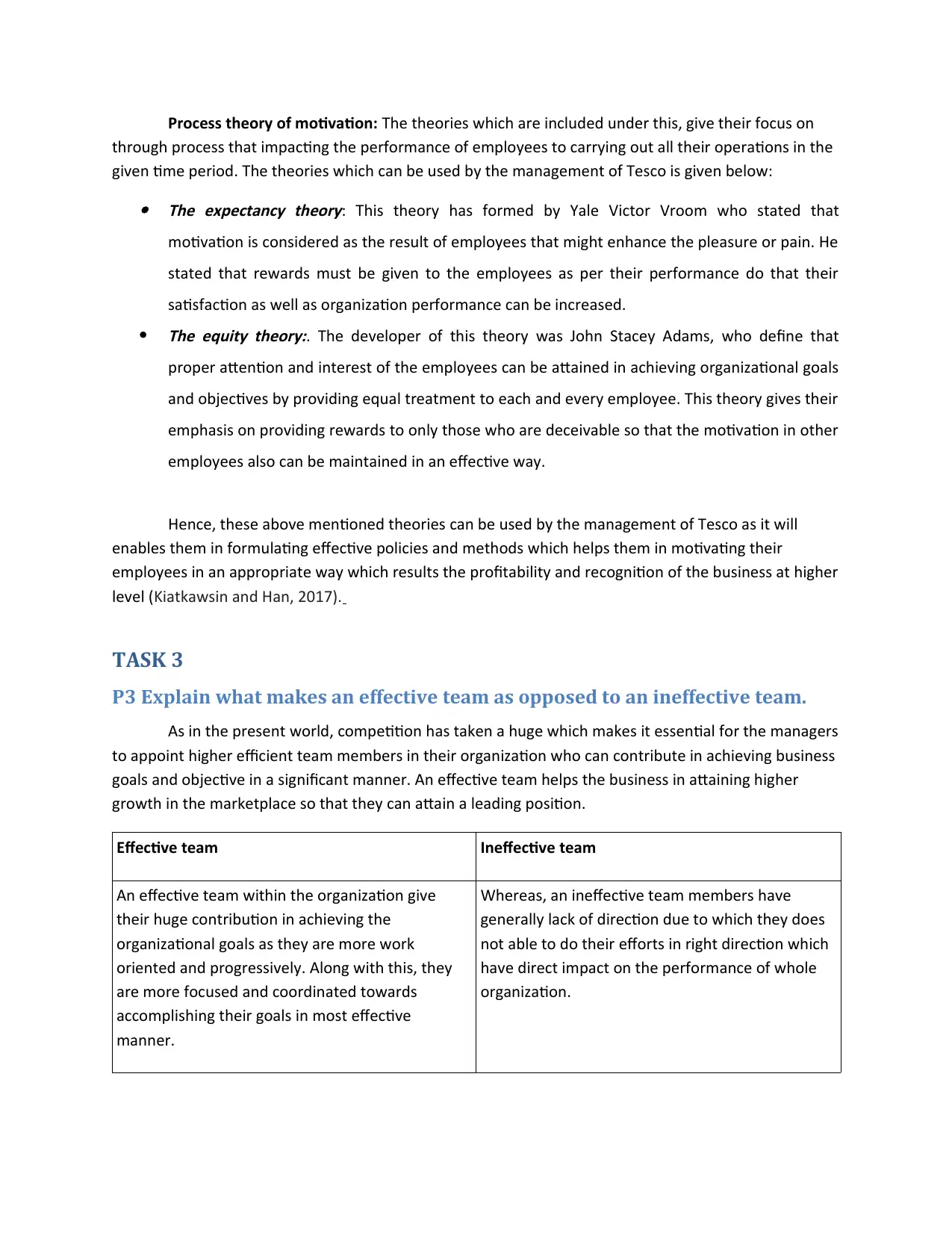
Process theory of motivation: The theories which are included under this, give their focus on
through process that impacting the performance of employees to carrying out all their operations in the
given time period. The theories which can be used by the management of Tesco is given below: The expectancy theory: This theory has formed by Yale Victor Vroom who stated that
motivation is considered as the result of employees that might enhance the pleasure or pain. He
stated that rewards must be given to the employees as per their performance do that their
satisfaction as well as organization performance can be increased.
The equity theory:. The developer of this theory was John Stacey Adams, who define that
proper attention and interest of the employees can be attained in achieving organizational goals
and objectives by providing equal treatment to each and every employee. This theory gives their
emphasis on providing rewards to only those who are deceivable so that the motivation in other
employees also can be maintained in an effective way.
Hence, these above mentioned theories can be used by the management of Tesco as it will
enables them in formulating effective policies and methods which helps them in motivating their
employees in an appropriate way which results the profitability and recognition of the business at higher
level (Kiatkawsin and Han, 2017).
TASK 3
P3 Explain what makes an effective team as opposed to an ineffective team.
As in the present world, competition has taken a huge which makes it essential for the managers
to appoint higher efficient team members in their organization who can contribute in achieving business
goals and objective in a significant manner. An effective team helps the business in attaining higher
growth in the marketplace so that they can attain a leading position.
Effective team Ineffective team
An effective team within the organization give
their huge contribution in achieving the
organizational goals as they are more work
oriented and progressively. Along with this, they
are more focused and coordinated towards
accomplishing their goals in most effective
manner.
Whereas, an ineffective team members have
generally lack of direction due to which they does
not able to do their efforts in right direction which
have direct impact on the performance of whole
organization.
through process that impacting the performance of employees to carrying out all their operations in the
given time period. The theories which can be used by the management of Tesco is given below: The expectancy theory: This theory has formed by Yale Victor Vroom who stated that
motivation is considered as the result of employees that might enhance the pleasure or pain. He
stated that rewards must be given to the employees as per their performance do that their
satisfaction as well as organization performance can be increased.
The equity theory:. The developer of this theory was John Stacey Adams, who define that
proper attention and interest of the employees can be attained in achieving organizational goals
and objectives by providing equal treatment to each and every employee. This theory gives their
emphasis on providing rewards to only those who are deceivable so that the motivation in other
employees also can be maintained in an effective way.
Hence, these above mentioned theories can be used by the management of Tesco as it will
enables them in formulating effective policies and methods which helps them in motivating their
employees in an appropriate way which results the profitability and recognition of the business at higher
level (Kiatkawsin and Han, 2017).
TASK 3
P3 Explain what makes an effective team as opposed to an ineffective team.
As in the present world, competition has taken a huge which makes it essential for the managers
to appoint higher efficient team members in their organization who can contribute in achieving business
goals and objective in a significant manner. An effective team helps the business in attaining higher
growth in the marketplace so that they can attain a leading position.
Effective team Ineffective team
An effective team within the organization give
their huge contribution in achieving the
organizational goals as they are more work
oriented and progressively. Along with this, they
are more focused and coordinated towards
accomplishing their goals in most effective
manner.
Whereas, an ineffective team members have
generally lack of direction due to which they does
not able to do their efforts in right direction which
have direct impact on the performance of whole
organization.
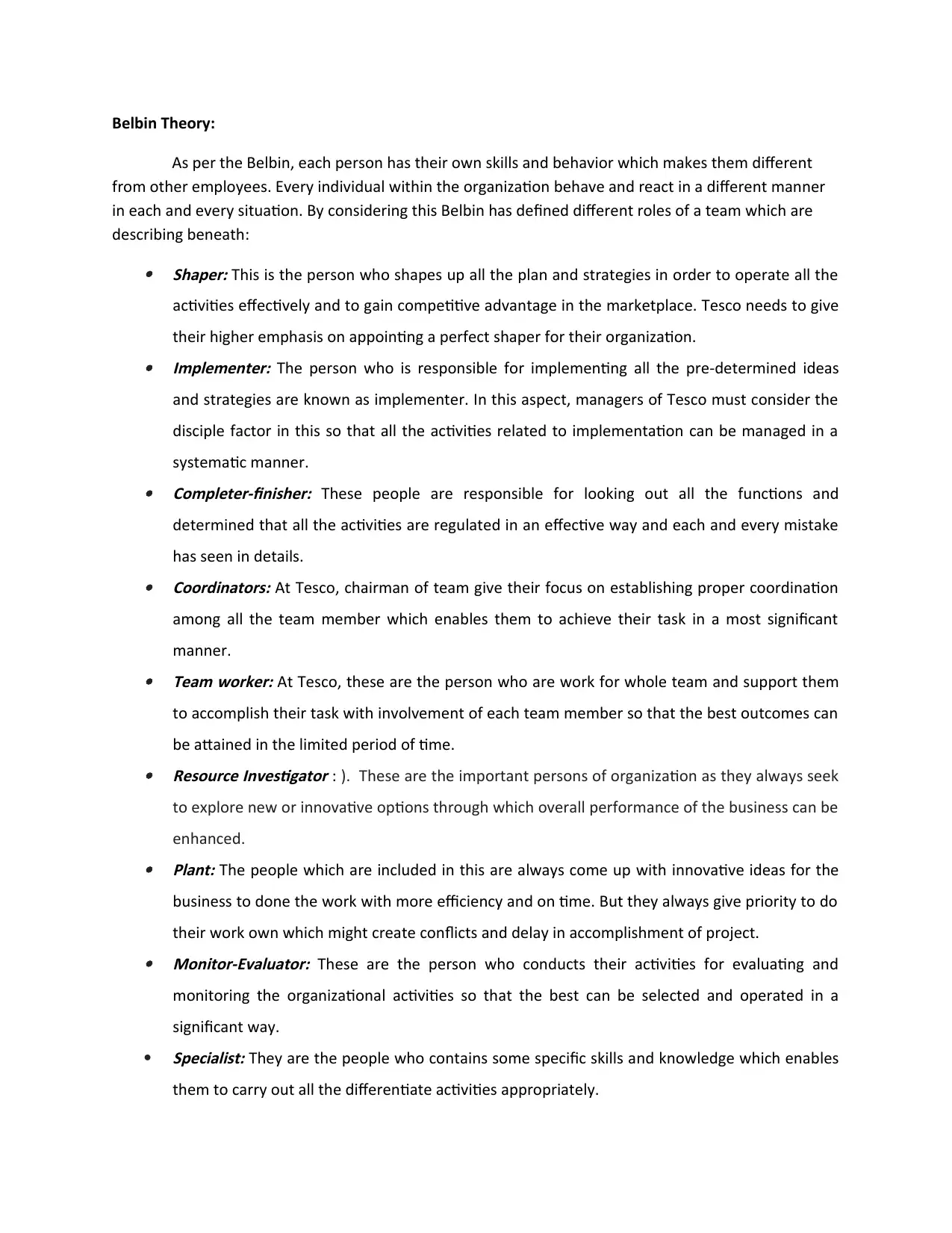
Belbin Theory:
As per the Belbin, each person has their own skills and behavior which makes them different
from other employees. Every individual within the organization behave and react in a different manner
in each and every situation. By considering this Belbin has defined different roles of a team which are
describing beneath: Shaper: This is the person who shapes up all the plan and strategies in order to operate all the
activities effectively and to gain competitive advantage in the marketplace. Tesco needs to give
their higher emphasis on appointing a perfect shaper for their organization. Implementer: The person who is responsible for implementing all the pre-determined ideas
and strategies are known as implementer. In this aspect, managers of Tesco must consider the
disciple factor in this so that all the activities related to implementation can be managed in a
systematic manner. Completer-finisher: These people are responsible for looking out all the functions and
determined that all the activities are regulated in an effective way and each and every mistake
has seen in details. Coordinators: At Tesco, chairman of team give their focus on establishing proper coordination
among all the team member which enables them to achieve their task in a most significant
manner. Team worker: At Tesco, these are the person who are work for whole team and support them
to accomplish their task with involvement of each team member so that the best outcomes can
be attained in the limited period of time. Resource Investigator : ). These are the important persons of organization as they always seek
to explore new or innovative options through which overall performance of the business can be
enhanced. Plant: The people which are included in this are always come up with innovative ideas for the
business to done the work with more efficiency and on time. But they always give priority to do
their work own which might create conflicts and delay in accomplishment of project. Monitor-Evaluator: These are the person who conducts their activities for evaluating and
monitoring the organizational activities so that the best can be selected and operated in a
significant way.
Specialist: They are the people who contains some specific skills and knowledge which enables
them to carry out all the differentiate activities appropriately.
As per the Belbin, each person has their own skills and behavior which makes them different
from other employees. Every individual within the organization behave and react in a different manner
in each and every situation. By considering this Belbin has defined different roles of a team which are
describing beneath: Shaper: This is the person who shapes up all the plan and strategies in order to operate all the
activities effectively and to gain competitive advantage in the marketplace. Tesco needs to give
their higher emphasis on appointing a perfect shaper for their organization. Implementer: The person who is responsible for implementing all the pre-determined ideas
and strategies are known as implementer. In this aspect, managers of Tesco must consider the
disciple factor in this so that all the activities related to implementation can be managed in a
systematic manner. Completer-finisher: These people are responsible for looking out all the functions and
determined that all the activities are regulated in an effective way and each and every mistake
has seen in details. Coordinators: At Tesco, chairman of team give their focus on establishing proper coordination
among all the team member which enables them to achieve their task in a most significant
manner. Team worker: At Tesco, these are the person who are work for whole team and support them
to accomplish their task with involvement of each team member so that the best outcomes can
be attained in the limited period of time. Resource Investigator : ). These are the important persons of organization as they always seek
to explore new or innovative options through which overall performance of the business can be
enhanced. Plant: The people which are included in this are always come up with innovative ideas for the
business to done the work with more efficiency and on time. But they always give priority to do
their work own which might create conflicts and delay in accomplishment of project. Monitor-Evaluator: These are the person who conducts their activities for evaluating and
monitoring the organizational activities so that the best can be selected and operated in a
significant way.
Specialist: They are the people who contains some specific skills and knowledge which enables
them to carry out all the differentiate activities appropriately.
⊘ This is a preview!⊘
Do you want full access?
Subscribe today to unlock all pages.

Trusted by 1+ million students worldwide
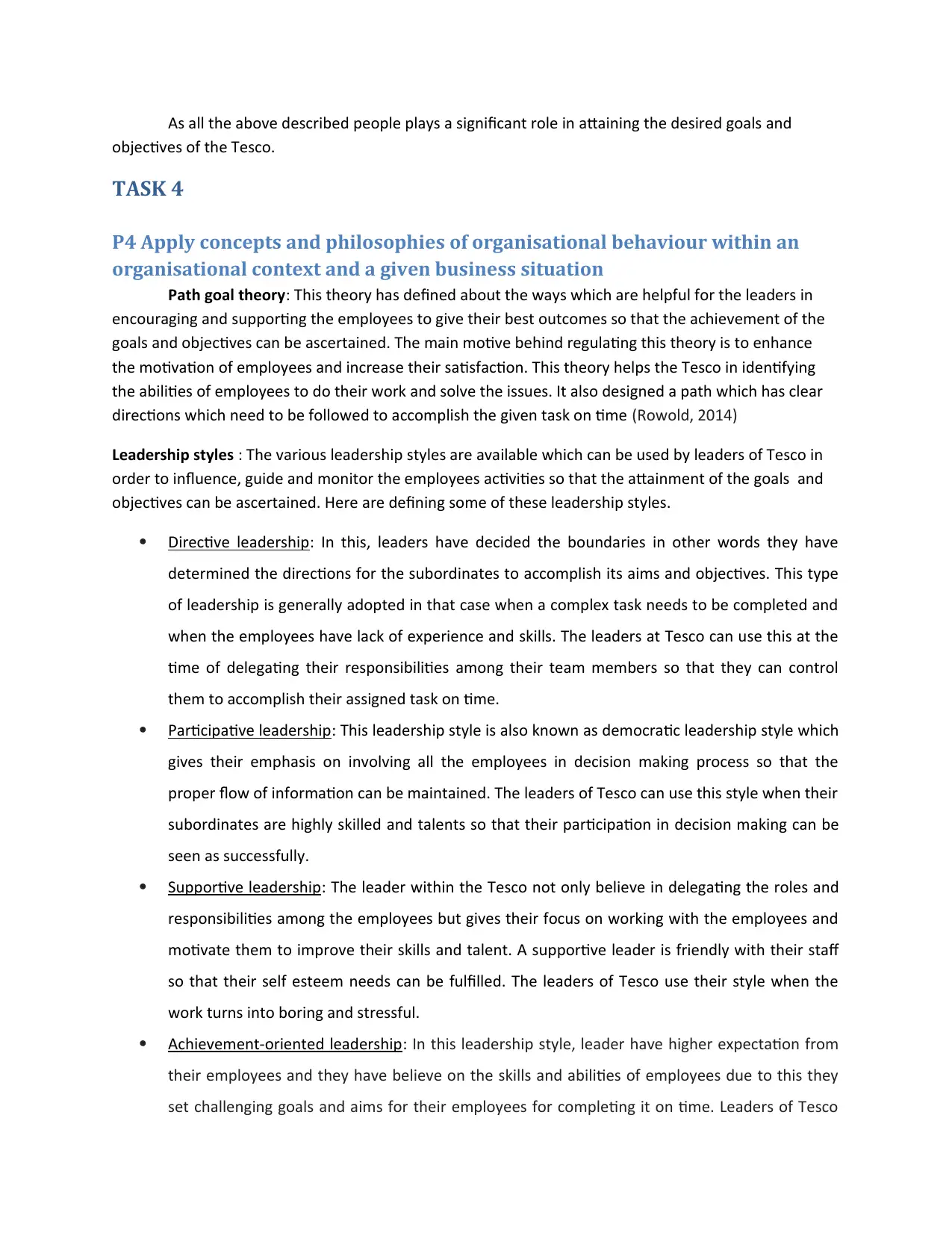
As all the above described people plays a significant role in attaining the desired goals and
objectives of the Tesco.
TASK 4
P4 Apply concepts and philosophies of organisational behaviour within an
organisational context and a given business situation
Path goal theory: This theory has defined about the ways which are helpful for the leaders in
encouraging and supporting the employees to give their best outcomes so that the achievement of the
goals and objectives can be ascertained. The main motive behind regulating this theory is to enhance
the motivation of employees and increase their satisfaction. This theory helps the Tesco in identifying
the abilities of employees to do their work and solve the issues. It also designed a path which has clear
directions which need to be followed to accomplish the given task on time (Rowold, 2014)
Leadership styles : The various leadership styles are available which can be used by leaders of Tesco in
order to influence, guide and monitor the employees activities so that the attainment of the goals and
objectives can be ascertained. Here are defining some of these leadership styles.
Directive leadership: In this, leaders have decided the boundaries in other words they have
determined the directions for the subordinates to accomplish its aims and objectives. This type
of leadership is generally adopted in that case when a complex task needs to be completed and
when the employees have lack of experience and skills. The leaders at Tesco can use this at the
time of delegating their responsibilities among their team members so that they can control
them to accomplish their assigned task on time.
Participative leadership: This leadership style is also known as democratic leadership style which
gives their emphasis on involving all the employees in decision making process so that the
proper flow of information can be maintained. The leaders of Tesco can use this style when their
subordinates are highly skilled and talents so that their participation in decision making can be
seen as successfully.
Supportive leadership: The leader within the Tesco not only believe in delegating the roles and
responsibilities among the employees but gives their focus on working with the employees and
motivate them to improve their skills and talent. A supportive leader is friendly with their staff
so that their self esteem needs can be fulfilled. The leaders of Tesco use their style when the
work turns into boring and stressful.
Achievement-oriented leadership: In this leadership style, leader have higher expectation from
their employees and they have believe on the skills and abilities of employees due to this they
set challenging goals and aims for their employees for completing it on time. Leaders of Tesco
objectives of the Tesco.
TASK 4
P4 Apply concepts and philosophies of organisational behaviour within an
organisational context and a given business situation
Path goal theory: This theory has defined about the ways which are helpful for the leaders in
encouraging and supporting the employees to give their best outcomes so that the achievement of the
goals and objectives can be ascertained. The main motive behind regulating this theory is to enhance
the motivation of employees and increase their satisfaction. This theory helps the Tesco in identifying
the abilities of employees to do their work and solve the issues. It also designed a path which has clear
directions which need to be followed to accomplish the given task on time (Rowold, 2014)
Leadership styles : The various leadership styles are available which can be used by leaders of Tesco in
order to influence, guide and monitor the employees activities so that the attainment of the goals and
objectives can be ascertained. Here are defining some of these leadership styles.
Directive leadership: In this, leaders have decided the boundaries in other words they have
determined the directions for the subordinates to accomplish its aims and objectives. This type
of leadership is generally adopted in that case when a complex task needs to be completed and
when the employees have lack of experience and skills. The leaders at Tesco can use this at the
time of delegating their responsibilities among their team members so that they can control
them to accomplish their assigned task on time.
Participative leadership: This leadership style is also known as democratic leadership style which
gives their emphasis on involving all the employees in decision making process so that the
proper flow of information can be maintained. The leaders of Tesco can use this style when their
subordinates are highly skilled and talents so that their participation in decision making can be
seen as successfully.
Supportive leadership: The leader within the Tesco not only believe in delegating the roles and
responsibilities among the employees but gives their focus on working with the employees and
motivate them to improve their skills and talent. A supportive leader is friendly with their staff
so that their self esteem needs can be fulfilled. The leaders of Tesco use their style when the
work turns into boring and stressful.
Achievement-oriented leadership: In this leadership style, leader have higher expectation from
their employees and they have believe on the skills and abilities of employees due to this they
set challenging goals and aims for their employees for completing it on time. Leaders of Tesco
Paraphrase This Document
Need a fresh take? Get an instant paraphrase of this document with our AI Paraphraser
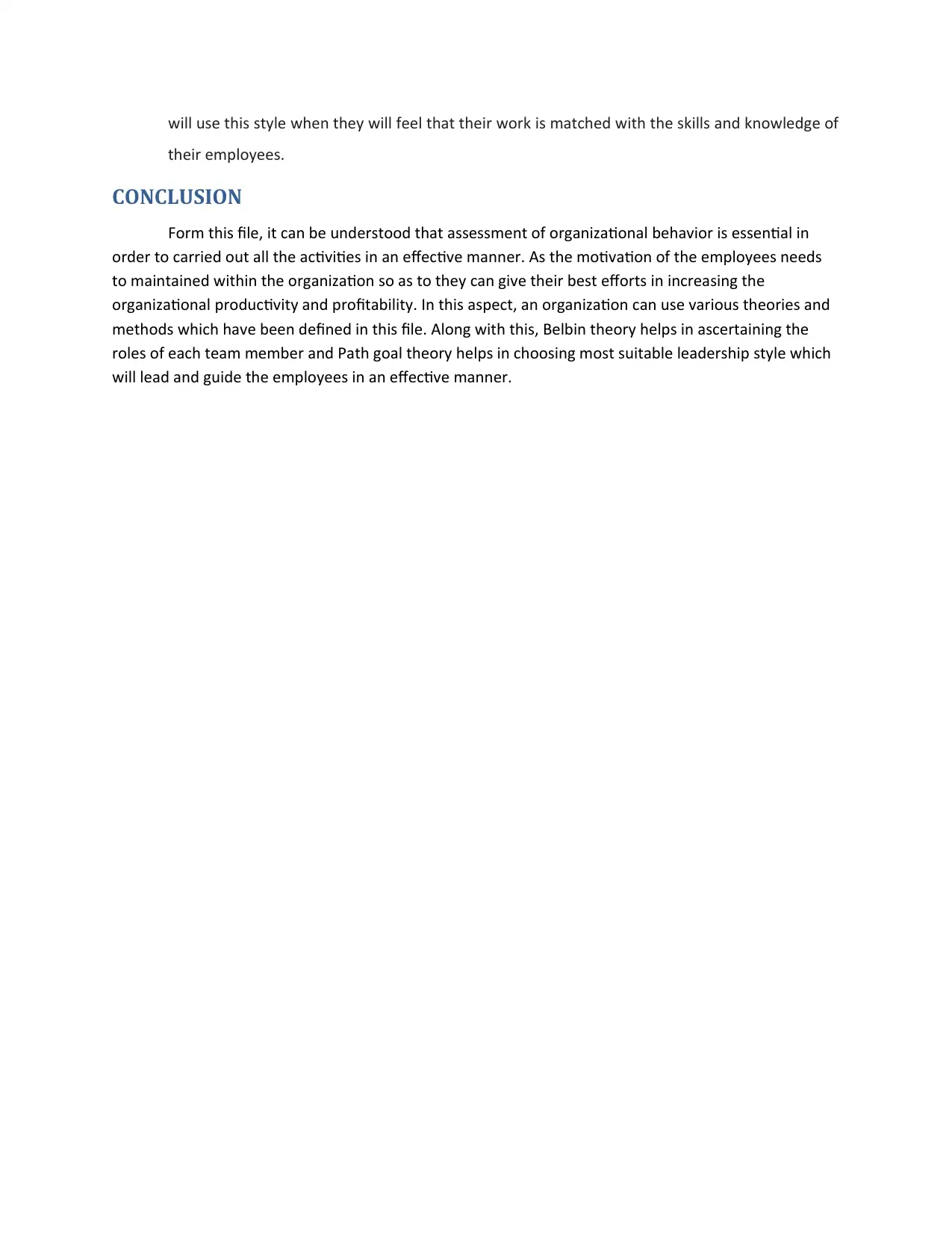
will use this style when they will feel that their work is matched with the skills and knowledge of
their employees.
CONCLUSION
Form this file, it can be understood that assessment of organizational behavior is essential in
order to carried out all the activities in an effective manner. As the motivation of the employees needs
to maintained within the organization so as to they can give their best efforts in increasing the
organizational productivity and profitability. In this aspect, an organization can use various theories and
methods which have been defined in this file. Along with this, Belbin theory helps in ascertaining the
roles of each team member and Path goal theory helps in choosing most suitable leadership style which
will lead and guide the employees in an effective manner.
their employees.
CONCLUSION
Form this file, it can be understood that assessment of organizational behavior is essential in
order to carried out all the activities in an effective manner. As the motivation of the employees needs
to maintained within the organization so as to they can give their best efforts in increasing the
organizational productivity and profitability. In this aspect, an organization can use various theories and
methods which have been defined in this file. Along with this, Belbin theory helps in ascertaining the
roles of each team member and Path goal theory helps in choosing most suitable leadership style which
will lead and guide the employees in an effective manner.
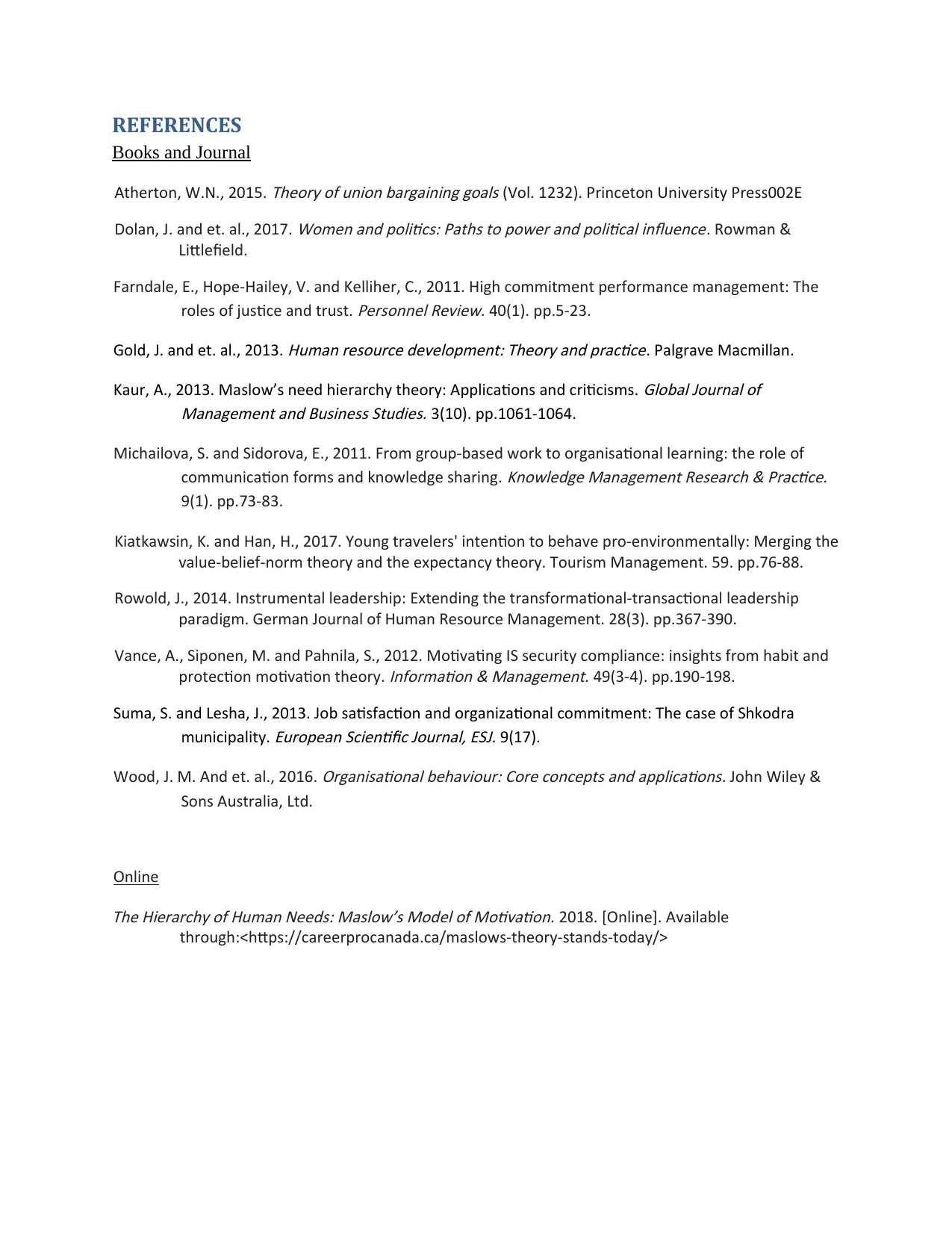
REFERENCES
Books and Journal
Atherton, W.N., 2015.
Theory of union bargaining goals (Vol. 1232). Princeton University Press002E
Dolan, J. and et. al., 2017.
Women and politics: Paths to power and political influence. Rowman &
Littlefield.
Farndale, E., Hope-Hailey, V. and Kelliher, C., 2011. High commitment performance management: The
roles of justice and trust.
Personnel Review. 40(1). pp.5-23.
Gold, J. and et. al., 2013.
Human resource development: Theory and practice. Palgrave Macmillan.
Kaur, A., 2013. Maslow’s need hierarchy theory: Applications and criticisms.
Global Journal of
Management and Business Studies. 3(10). pp.1061-1064.
Michailova, S. and Sidorova, E., 2011. From group-based work to organisational learning: the role of
communication forms and knowledge sharing.
Knowledge Management Research & Practice.
9(1). pp.73-83.
Kiatkawsin, K. and Han, H., 2017. Young travelers' intention to behave pro-environmentally: Merging the
value-belief-norm theory and the expectancy theory. Tourism Management. 59. pp.76-88.
Rowold, J., 2014. Instrumental leadership: Extending the transformational-transactional leadership
paradigm. German Journal of Human Resource Management. 28(3). pp.367-390.
Vance, A., Siponen, M. and Pahnila, S., 2012. Motivating IS security compliance: insights from habit and
protection motivation theory.
Information & Management. 49(3-4). pp.190-198.
Suma, S. and Lesha, J., 2013. Job satisfaction and organizational commitment: The case of Shkodra
municipality.
European Scientific Journal, ESJ. 9(17).
Wood, J. M. And et. al., 2016.
Organisational behaviour: Core concepts and applications. John Wiley &
Sons Australia, Ltd.
Online
The Hierarchy of Human Needs: Maslow’s Model of Motivation. 2018. [Online]. Available
through:<https://careerprocanada.ca/maslows-theory-stands-today/>
Books and Journal
Atherton, W.N., 2015.
Theory of union bargaining goals (Vol. 1232). Princeton University Press002E
Dolan, J. and et. al., 2017.
Women and politics: Paths to power and political influence. Rowman &
Littlefield.
Farndale, E., Hope-Hailey, V. and Kelliher, C., 2011. High commitment performance management: The
roles of justice and trust.
Personnel Review. 40(1). pp.5-23.
Gold, J. and et. al., 2013.
Human resource development: Theory and practice. Palgrave Macmillan.
Kaur, A., 2013. Maslow’s need hierarchy theory: Applications and criticisms.
Global Journal of
Management and Business Studies. 3(10). pp.1061-1064.
Michailova, S. and Sidorova, E., 2011. From group-based work to organisational learning: the role of
communication forms and knowledge sharing.
Knowledge Management Research & Practice.
9(1). pp.73-83.
Kiatkawsin, K. and Han, H., 2017. Young travelers' intention to behave pro-environmentally: Merging the
value-belief-norm theory and the expectancy theory. Tourism Management. 59. pp.76-88.
Rowold, J., 2014. Instrumental leadership: Extending the transformational-transactional leadership
paradigm. German Journal of Human Resource Management. 28(3). pp.367-390.
Vance, A., Siponen, M. and Pahnila, S., 2012. Motivating IS security compliance: insights from habit and
protection motivation theory.
Information & Management. 49(3-4). pp.190-198.
Suma, S. and Lesha, J., 2013. Job satisfaction and organizational commitment: The case of Shkodra
municipality.
European Scientific Journal, ESJ. 9(17).
Wood, J. M. And et. al., 2016.
Organisational behaviour: Core concepts and applications. John Wiley &
Sons Australia, Ltd.
Online
The Hierarchy of Human Needs: Maslow’s Model of Motivation. 2018. [Online]. Available
through:<https://careerprocanada.ca/maslows-theory-stands-today/>
⊘ This is a preview!⊘
Do you want full access?
Subscribe today to unlock all pages.

Trusted by 1+ million students worldwide
1 out of 13
Related Documents
Your All-in-One AI-Powered Toolkit for Academic Success.
+13062052269
info@desklib.com
Available 24*7 on WhatsApp / Email
![[object Object]](/_next/static/media/star-bottom.7253800d.svg)
Unlock your academic potential
Copyright © 2020–2025 A2Z Services. All Rights Reserved. Developed and managed by ZUCOL.





